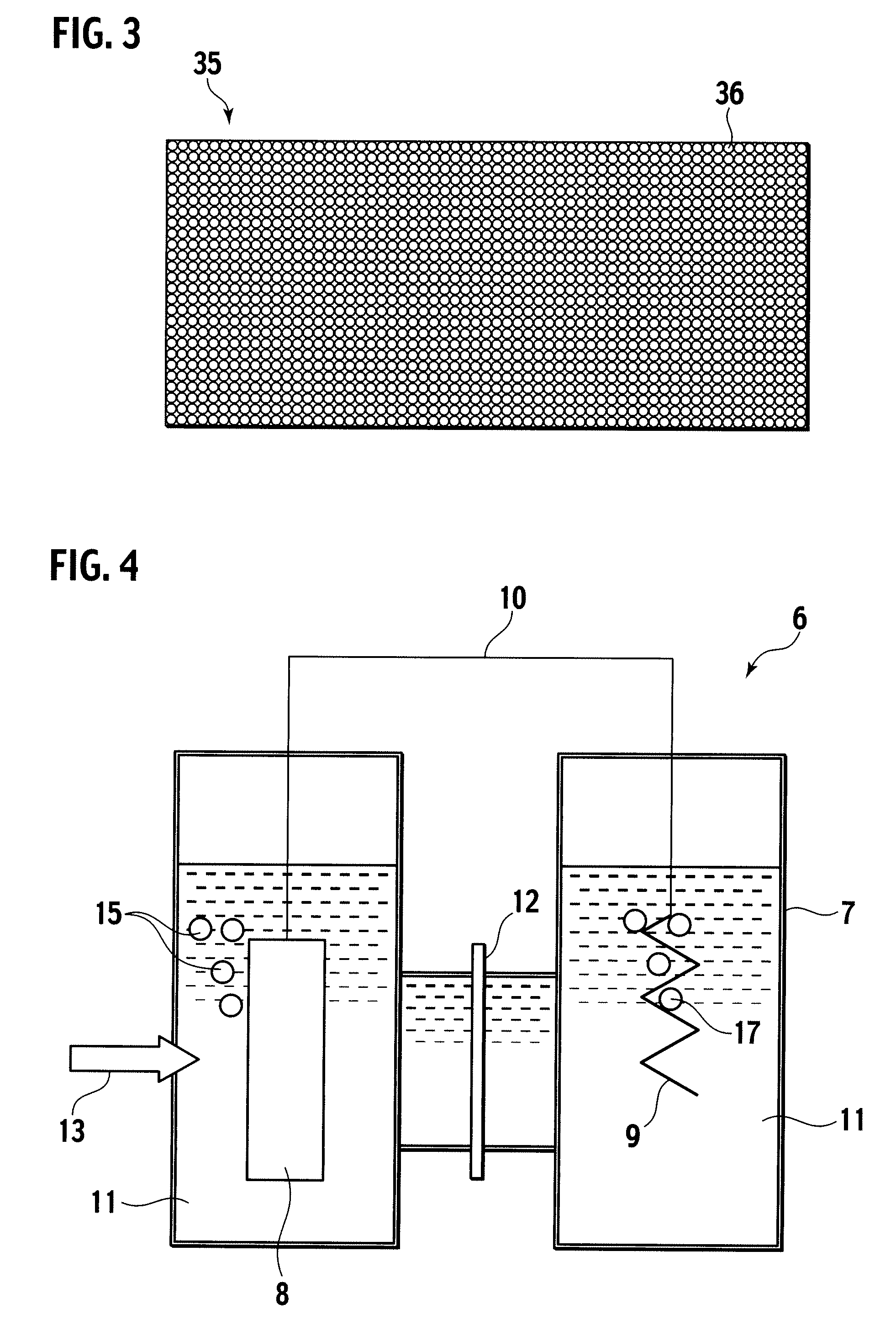Semiconductor photoelectrode, method for manufacturing the same, and light energy converting device
a semiconductor photoelectrode and photoelectrode technology, applied in the direction of catalyst activation/preparation, metal/metal-oxide/metal-hydroxide catalyst, final product manufacturing, etc., can solve the problems of reducing reducing and the photoelectric conversion efficiency of the semiconductor photoelectrode including the conventional metallic substrate is not so high, and the effect of increasing the light absorption efficiency
- Summary
- Abstract
- Description
- Claims
- Application Information
AI Technical Summary
Benefits of technology
Problems solved by technology
Method used
Image
Examples
examples 1 to 3
[0049]In Examples 1 to 3, as the metallic substrate 2, Ti porous bodies were used, which were produced by heating and pressurizing Ti metallic particles with an average size of 45 μm for necking. The Ti porous bodies had arithmetic average roughnesses (Ra) of about 2 μm and maximum heights (Ry) of about 5 μm.
[0050]These Ti porous bodies were heated for one hour in an air atmosphere at different temperatures in a range from 500 to 700° C. The heating temperatures were 500° C. in Example 1, 600° C. in Example 2, and 700° C. in Example 3. The surfaces of the Ti porous bodies were oxidized by the heating to produce TiO2 layers.
[0051]Identifying the structure by means of X ray diffraction (XRD) revealed that TiO2 was rutile. As apparent from the result of the cross sectional SEM analysis, the higher heating temperature provided the TiO2 layer with greater thickness. The thicknesses of the TiO2 layers, which varied depending on the location of measurement, were 100 nm in Example 1, 200 nm...
examples 4 and 5
[0053]In Examples 4 and 5, as the metallic substrate 2, Ti plates 31 having irregularities in the surfaces were used. The Ti plates were produced by etching Ti plates patterned with a photoresist mask. The surface of each Ti plate was shaped as shown in FIG. 7(a). FIG. 7(b) shows an A-A′ cross-sectional view of the surface of the Ti plate shown in FIG. 7(a). In Example 4, X and Y shown in FIG. 7(b) were 5 and 70 μm, respectively. In Example 5, X and Y shown in FIG. 7(b) were 40 and 70 μm, respectively. The arithmetic average roughnesses (Ra) of the Ti plates of Examples 4 and 5 measured 3.0 μm and 3.3 μm, respectively.
[0054]Each obtained Ti plate was heated for one hour in an air atmosphere at a temperature of 700° C. for oxidization of the surface of the Ti plate, thus producing the TiO2 layer. The thicknesses of the TiO2 layers of Examples 4 and 5, which varied depending on the location of measurement, were 600 μm.
example 6
[0055]In Example 6, first, hydrated colloid of WO3 was prepared. The hydrated colloid of WO3 was prepared by proton exchange for Na+ ions within Na2WO4 aqueous solution using ion exchange resin. The thus-obtained hydrated colloid aqueous solution was mixed with an equal amount of ethanol and then subjected to vacuum distillation (60° C.), so that the volume thereof was reduced to a quarter. Thereafter, the obtained solution was added with polyethylene glycol 300 (Wako Pure Chemical Industries, Ltd.) as much as half the obtained solution and then mixed using a stirrer, thus obtaining slurry composed of colloidal WO3.
[0056]The obtained slurry was applied on the same Ti porous body as that of Example 1 and then heated at 500° C. for one hour, thus producing a WO3 layer on the Ti porous body. The WO3 layer was an aggregate of particles and had irregularities in the surface, but the thickness of the WO3 layer was not uniform and could not be measured.
PUM
| Property | Measurement | Unit |
|---|---|---|
| roughness | aaaaa | aaaaa |
| thickness | aaaaa | aaaaa |
| particle size | aaaaa | aaaaa |
Abstract
Description
Claims
Application Information
 Login to View More
Login to View More - R&D
- Intellectual Property
- Life Sciences
- Materials
- Tech Scout
- Unparalleled Data Quality
- Higher Quality Content
- 60% Fewer Hallucinations
Browse by: Latest US Patents, China's latest patents, Technical Efficacy Thesaurus, Application Domain, Technology Topic, Popular Technical Reports.
© 2025 PatSnap. All rights reserved.Legal|Privacy policy|Modern Slavery Act Transparency Statement|Sitemap|About US| Contact US: help@patsnap.com



